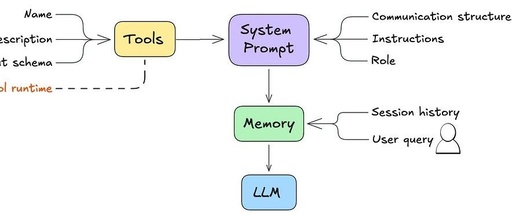Hello everyone, I am Xuan Jie.
Before we start the main content, let me promote myself. The New Year is approaching, to give back to the support of my fans, the original price of 199 yuan for the “3-Day AI Agent Project Practical Live Training Camp”, is directly reduced to 19 yuan, and today we open up one more day of registration privileges, limited to 99 people.
Back to the main topic.
The AI Agent currently refers more specifically to the LLM Agent. This is a program whose execution logic is controlled by its underlying large model (LLM)..
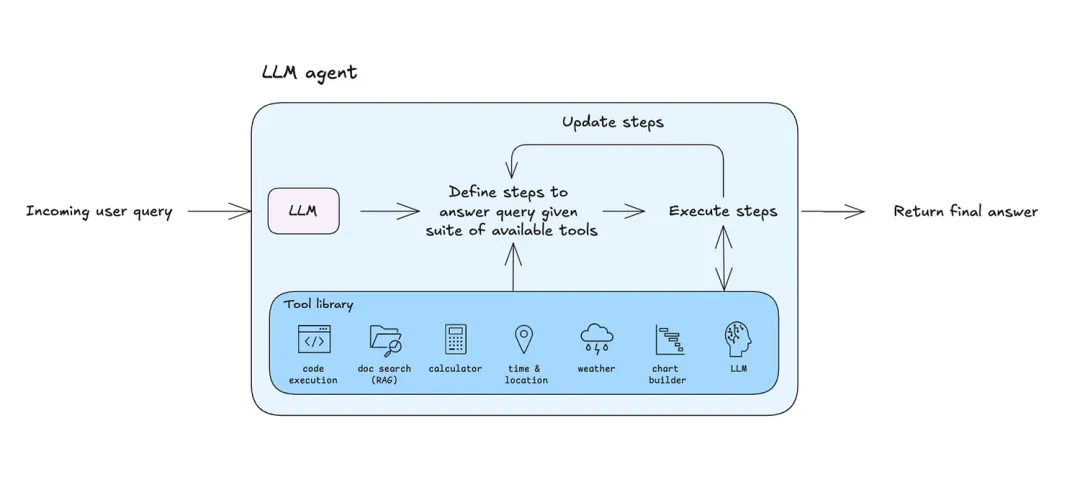
Compared to few-shot prompting or fixed workflows, the uniqueness of the LLM Agent lies in its ability to define and adjust the steps needed to execute user queries. If it can access a range of tools (such as code execution or web search), the AI Agent can decide which tools to use, how to apply them, and iteratively optimize based on output results. This flexibility allows the system to handle diverse application scenarios with minimal configuration.
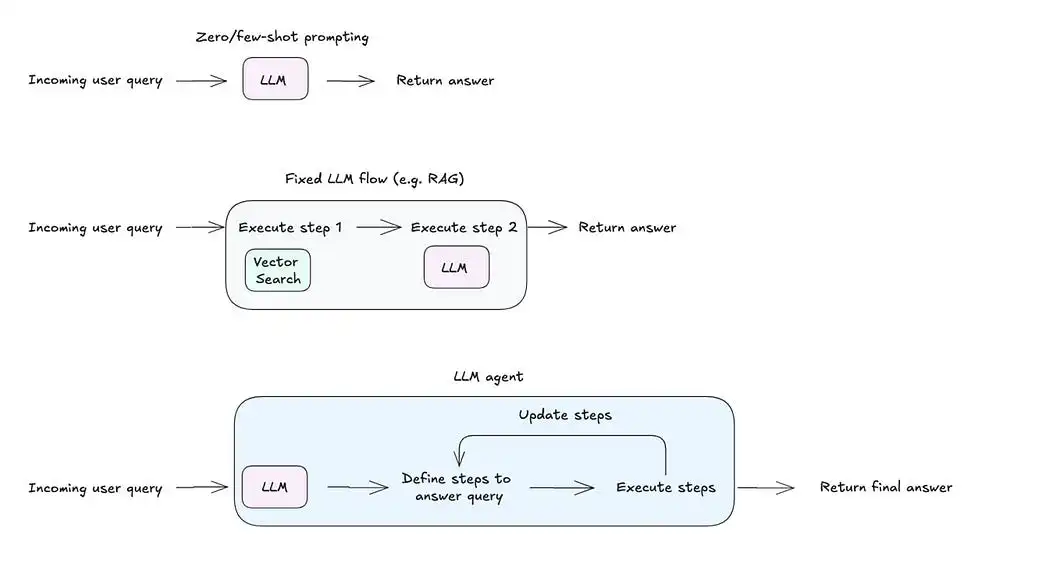
The architecture of the AI Agent encompasses a wide range from the reliability of fixed workflows to autonomous AI Agents. For example, a fixed process like Retrieval-Augmented Generation (RAG) can be optimized through self-reflection loops, allowing the program to improve when initial responses are insufficient. The ReAct Agent can also be equipped with fixed processes as tools, providing a flexible yet structured approach. The choice of architecture ultimately depends on the specific application scenario and the best balance between reliability and flexibility.

Next, I will show you the detailed guide to AI Agent development, which consists of 8 steps, detailed below.
—1—
Step 1: Choose the Right Large Model (LLM)
-
Massive Multitask Language Understanding (MMLU) (for reasoning capabilities); -
Berkeley Function Calling Rankings (for tool selection and invocation); -
HumanEval and BigCodeBench (for coding abilities);
Another important consideration is the context window size of the large model. The workflow of the AI Agent may consume a large number of tokens—sometimes reaching 100,000 or more—so a larger context window will be very beneficial.
Here are some large models you might consider:
-
Closed-source models: GPT4-o, Claude 3.5
-
Open-source models: Llama 3.2, Qwen 2.5
Generally speaking, the larger the model, the better the performance, but smaller models that can run locally are also a good choice. For smaller models, you may only be able to handle simpler use cases and may only connect your AI Agent with one or two basic tools.
—2—
Step 2: Define the Control Logic of the AI Agent
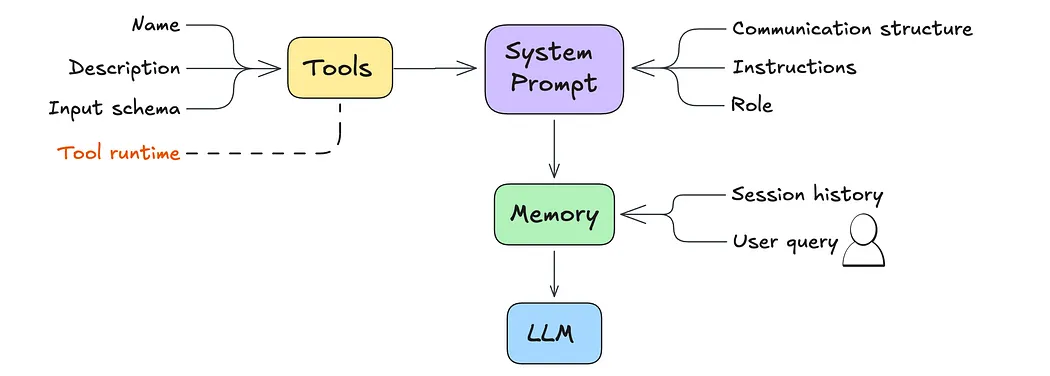
In the context of large models, the system prompt is a series of instructions and background information provided to the model before it begins processing user queries.
It can explicitly define the behaviors the AI Agent should exhibit.
Here are some common AI Agent modes that can be adjusted according to your specific needs:
-
Tool Usage: The AI Agent determines when to direct the query to the appropriate tool or when to rely on its own knowledge base.
-
Reflection: The AI Agent reviews and corrects its answer before replying to the user. Most LLM systems can also include a reflection step.
-
ReAct:The AI Agent continuously reasons about how to solve the query, executes actions, observes results, and decides whether further action or responses are needed.
-
Plan Then Execute: The AI Agent pre-plans tasks and, if necessary, breaks them down into sub-steps, then executes these steps one by one.
The last two modes (ReAct and Plan Then Execute) are often a good starting point for building a multifunctional single AI Agent..

To effectively implement these behaviors, some prompt engineering is necessary. You may also need to utilize structured generation techniques. This essentially guides the output of the large model to conform to a specific format or pattern to ensure the AI Agent’s responses align with your expected communication style.
—3—
Step 3: Define the Core Instructions of the AI Agent
We often assume that large models have a series of immediate functions. While some functions may be excellent, others may not fully meet our expectations. To achieve the performance we strive for, it is crucial to elaborate on the functions we want to include and exclude in the system prompt.
This may involve the following guidance:
-
Name and Role of the AI Agent: Specify the name and purpose of the AI Agent.
-
Tone and Brevity: Determine whether the AI Agent’s responses should be formal or informal, and the degree of brevity.
-
When to Use Tools: Clearly state when to rely on external tools rather than the model’s own knowledge base.
-
Error Handling: Guide the AI Agent on what actions to take when encountering tool or process issues.
—4—
Step 4: Define and Optimize Your Core Tools
Tools provide your AI Agent with extraordinary capabilities. By using a well-defined set of tools, you can achieve diverse functionalities. Essential tools include code execution, web search, file reading, and data analysis.
For each tool, you need to define the following and incorporate them into the system prompt:
-
Tool Name: Provide a unique and descriptive name for the functionality.
-
Tool Description: Clearly articulate the tool’s purpose and applicable scenarios. This helps the AI Agent determine when to select that tool.
-
Tool Input Format: Describe the required and optional parameters, their types, and any relevant constraints. The AI Agent will use this information to fill in the required input based on user queries.
-
Instructions regarding where or how to run the tool.
In some cases, you may need to optimize the tool to achieve the expected performance. This may include quick engineering adjustments to tool names or descriptions, setting advanced configurations to handle common issues, or filtering the tool’s output.
—5—
Step 5: Develop a Reliable Memory Management Strategy
Large models are limited by their context window, which is the number of tokens they can “remember” at once.This memory space can quickly become filled with historical exchanges from multi-turn conversations, lengthy tool outputs, or additional context relied upon by the AI Agent. Therefore, establishing an effective memory management strategy is crucial.
Within the framework of the AI Agent, memory involves the system’s ability to store, retrieve, and utilize past interaction information. This allows the AI Agent to maintain context over time, optimize its responses based on previous exchanges, and deliver a more personalized experience.
Common memory management strategies include:
-
Sliding Memory: Retain the memory of the last k rounds of dialogue while removing earlier rounds.
-
Token Memory: Retain the last n tokens and forget other tokens.
-
Summarized Memory: Summarize each dialogue round using the large model and remove individual messages.
Additionally, you can train the large model to recognize key information to store in long-term memory. This way, the AI Agent can “remember” important details about the user, providing a more personalized experience.
Thus far, the five steps we have outlined lay the foundation for building an AI Agent. But what would happen if we processed user queries through the large model at this stage?
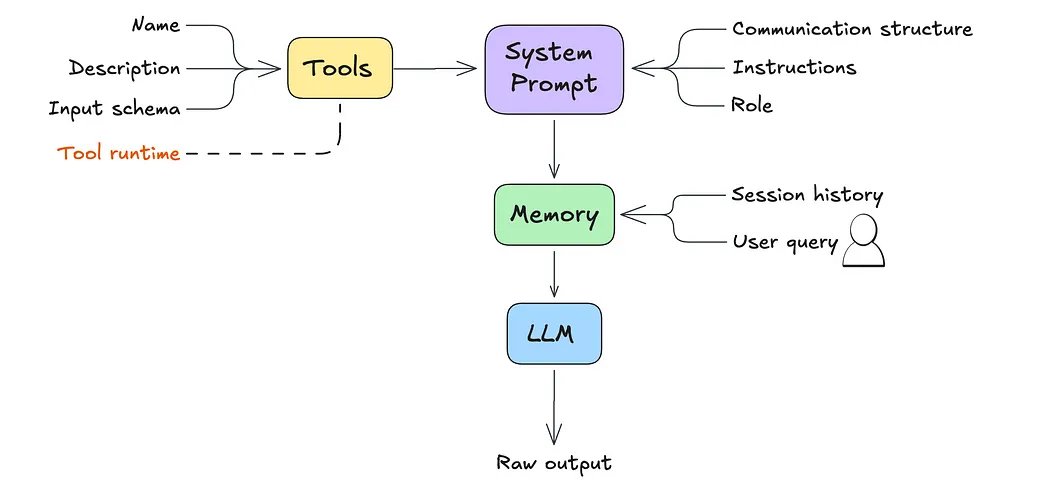
At this point, the AI Agent will generate raw text output. So how do we make it perform subsequent actions? This requires parsing and orchestration capabilities.
—6—
Step 6: Parse the Raw Output of the AI Agent
A parser is a function responsible for converting raw data into a format that the application can understand and operate, such as objects with attributes.
When building our AI Agent, the parser needs to recognize the communication structure set in Step 2 and output structured data, such as JSON format. This makes it easier for the application to handle and execute the subsequent actions of the AI Agent.
Note: Some model providers (such as OpenAI) may provide output that can be parsed directly by default. For other models, especially open-source models, additional configurations may be needed to generate parsable output.
—7—
Step 7: Arrange the Next Actions of the AI Agent
The final step is to establish orchestration logic. This logic determines what will happen after the large model generates output. Based on the output content, you can perform the following actions:
-
Invoke a Tool, or
-
Return an Answer — this can be a direct response to the user query or a follow-up action requesting more information.
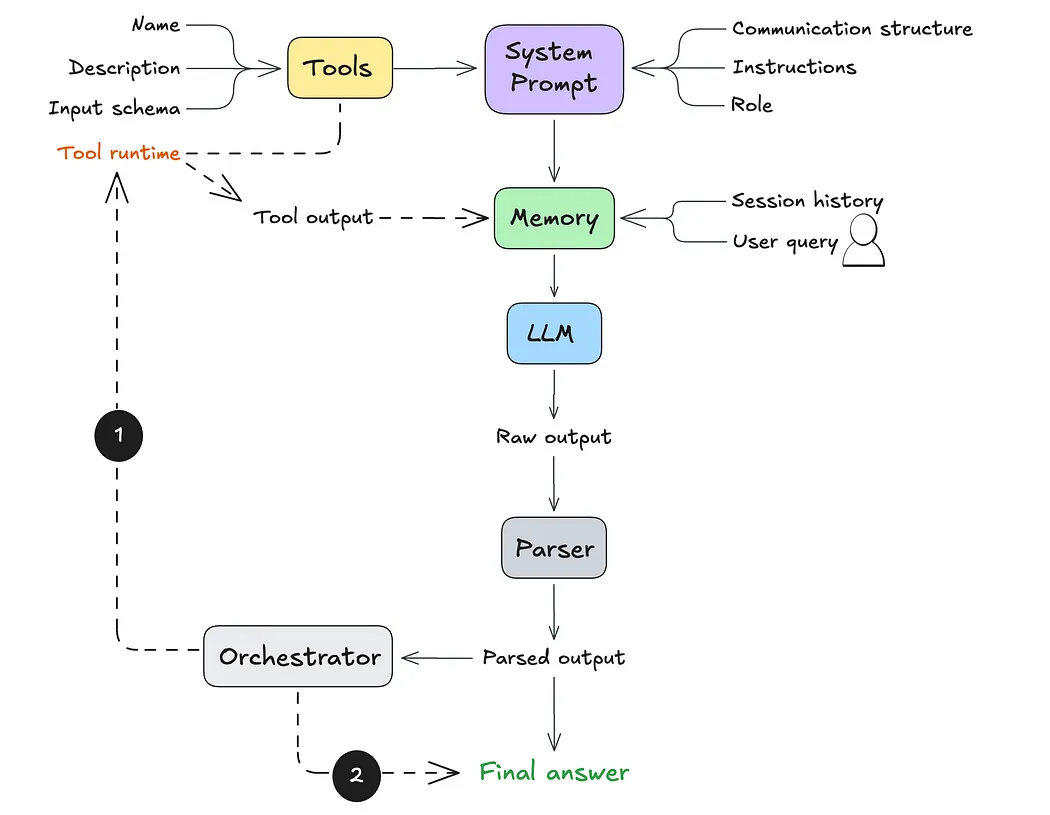
When a tool invocation is triggered, the tool’s output will be sent back to the large model (as part of its working memory). Subsequently, the large model will decide how to process this new data: whether to make another tool call or provide an answer to the user.
Here is an example of implementing such orchestration logic in code:
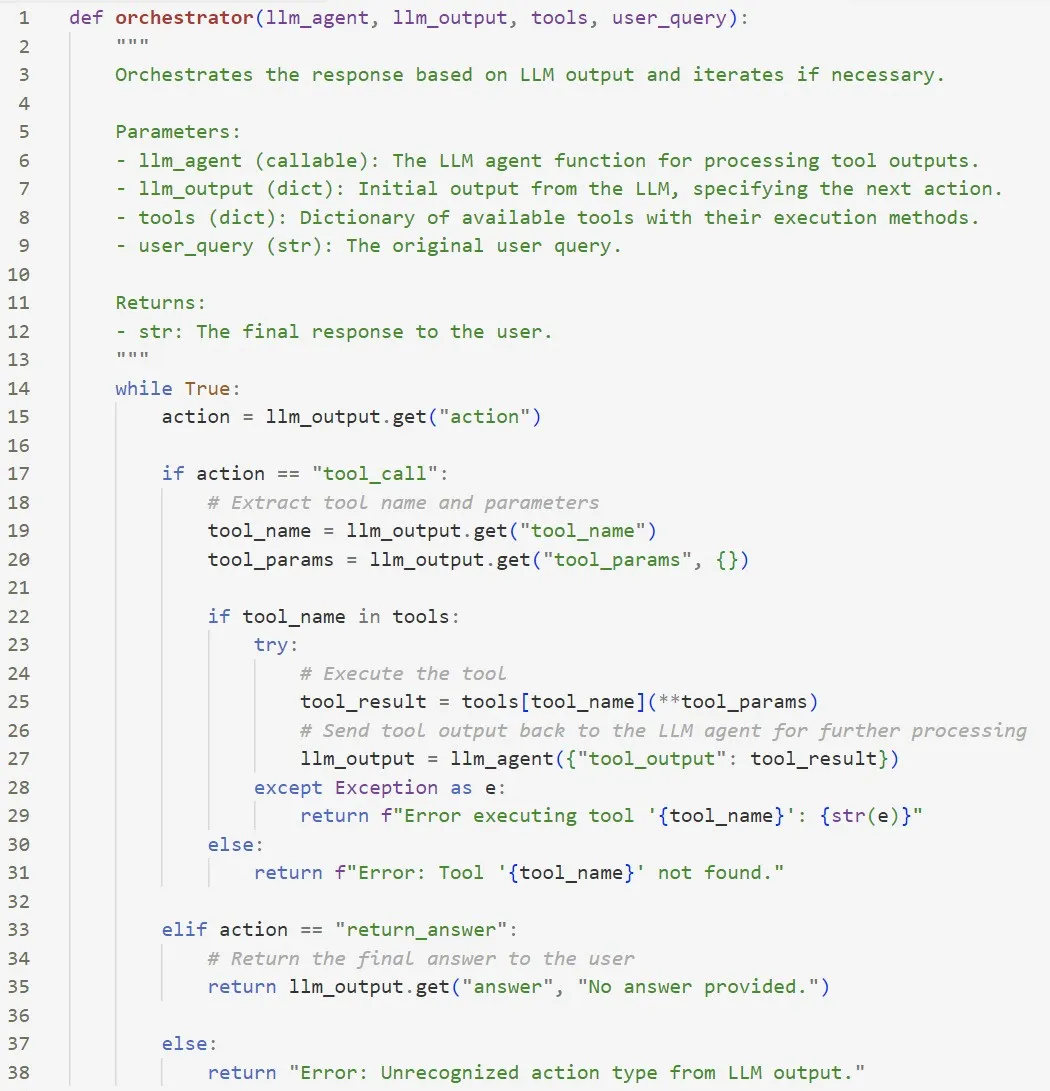
—8—
Step 8: Design Multiple AI Agents
Although current large models are very powerful, they face a major challenge: the limited ability to handle information overload. Excessive context or tool usage may lead to the model being overwhelmed, affecting performance. A single general AI Agent may eventually reach this limit, especially considering the huge demand for tokens.
In some cases, adopting a multi-AI Agent architecture may be more appropriate. By distributing tasks among multiple AI Agents, you can avoid the context overload of a single LLM Agent and improve overall operational efficiency.
Nevertheless, a single general AI Agent architecture is an excellent starting point for prototyping. It allows you to quickly validate use cases and identify points where the system begins to experience issues. Through this process, you can:
-
Understand which parts of the task truly benefit from the AI Agent approach.
-
Identify components that can be separated as independent modules in more complex workflows.
Starting from a single AI Agent can provide valuable insights that help optimize your approach when scaling to more complex systems.
Ready to dive deep and start building? Using frameworks is an effective way to quickly test and iterate AI Agent configurations:
If you plan to use open-source models like Llama 3, you can try the Bee Agent Framework.
If you plan to use cutting-edge models like OpenAI, you can try LangGraph.
In summary, AI Agent technology is so important; how can we quickly and systematically master it? My team and I have been working on large model projects for two years, helping more than 60 enterprises implement nearly 100 projects. Based on our enterprise-level practical project experience, we created a 3-day AI Agent project practical live training camp. As of today, 20,000 students have registered, which is incredibly popular! Original price: 199 yuan, the New Year is approaching, to give back to the support of fans, the price is directly reduced to 19 yuan, and today we open up one more day of registration privileges, limited to 99 people, and once sold out, it will immediately return to 199 yuan.
—9—
Why is the AI Agent so important?
First, this is the trend of the times, we are experiencing a major technological transformation, unlike the rise of the internet in the past; this is a disruptive transformation. Falling behind means elimination because all applications in the future will be rewritten by AI Agents;
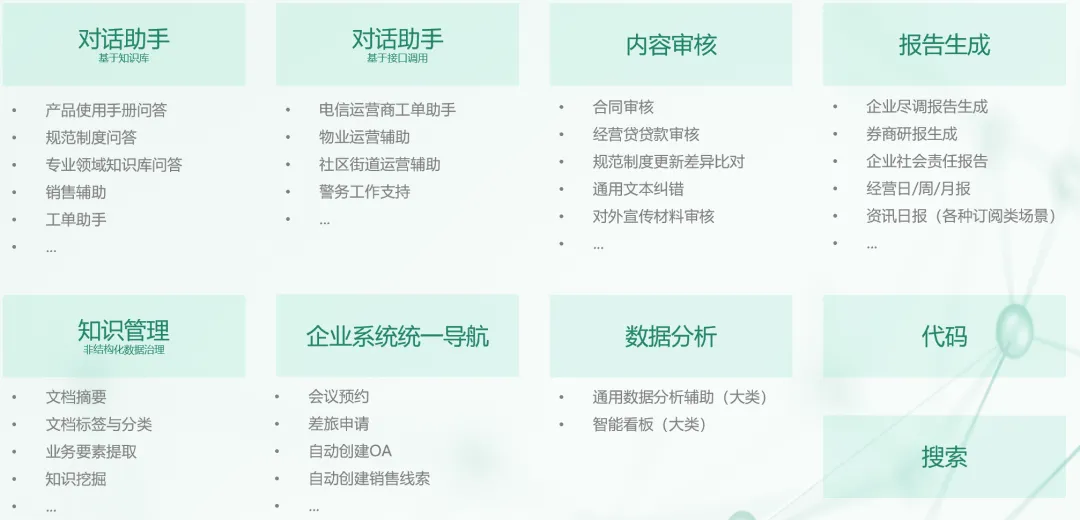
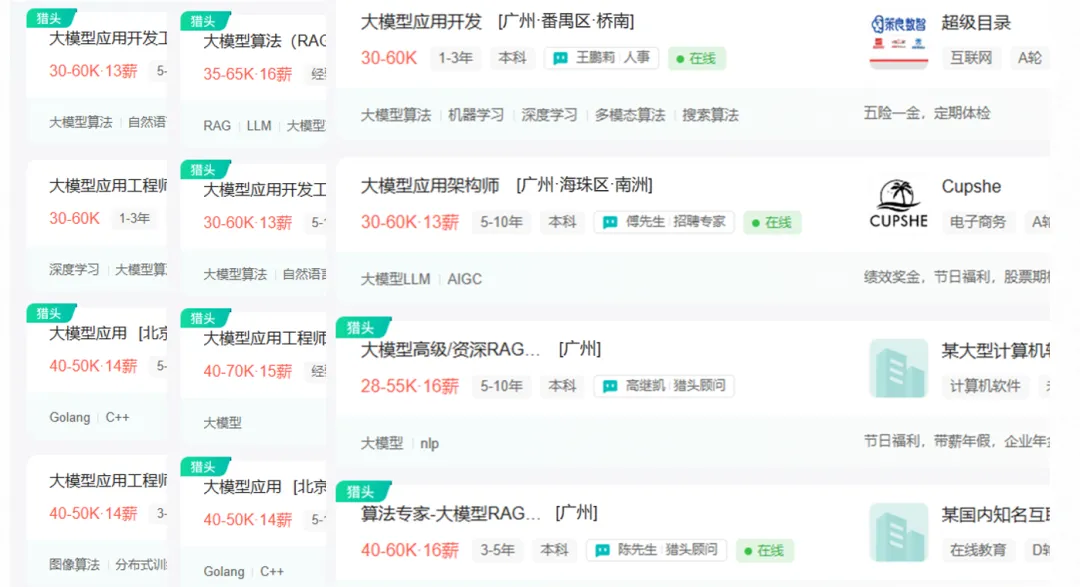
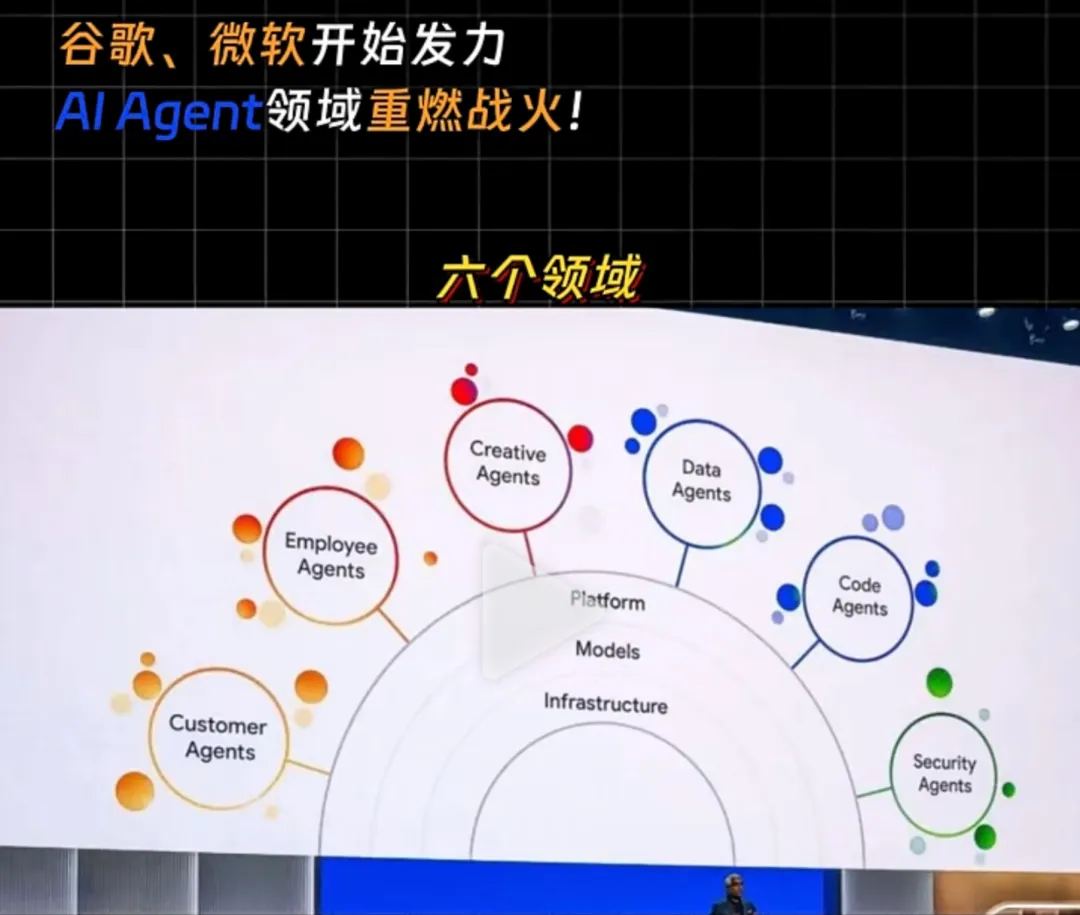
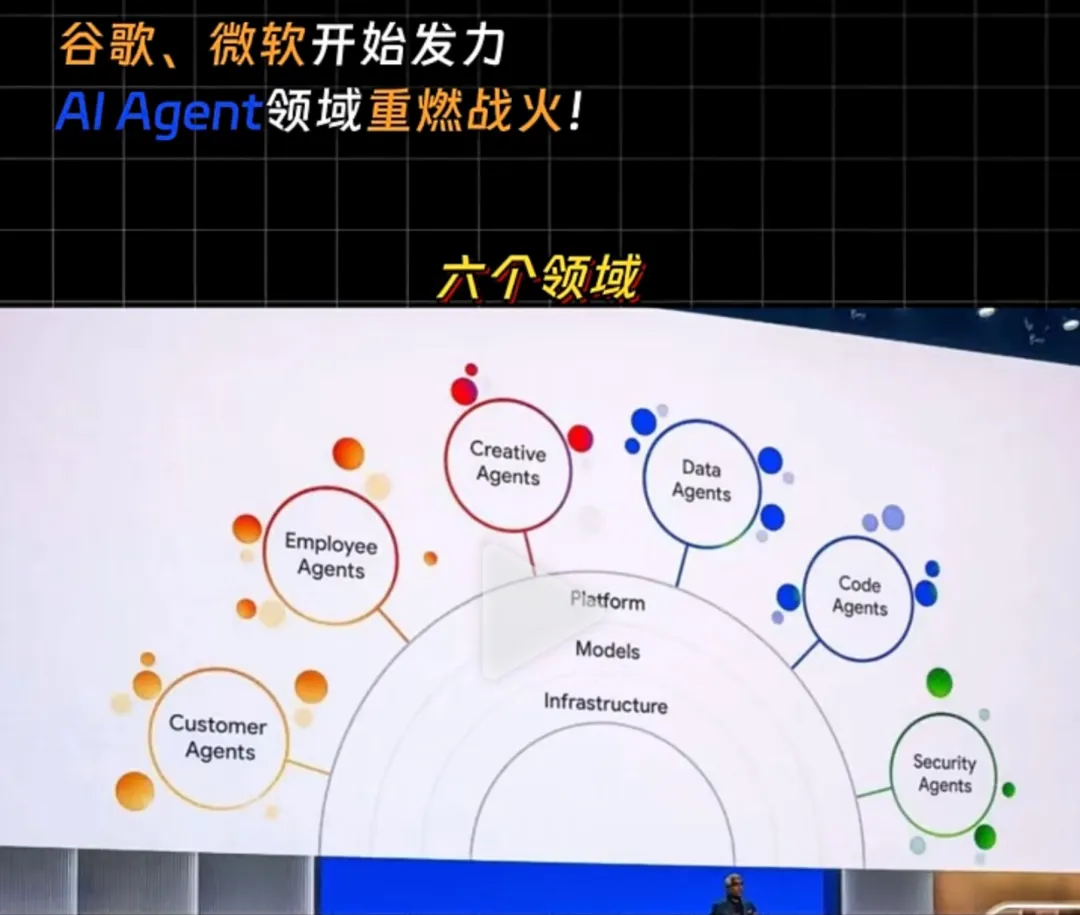
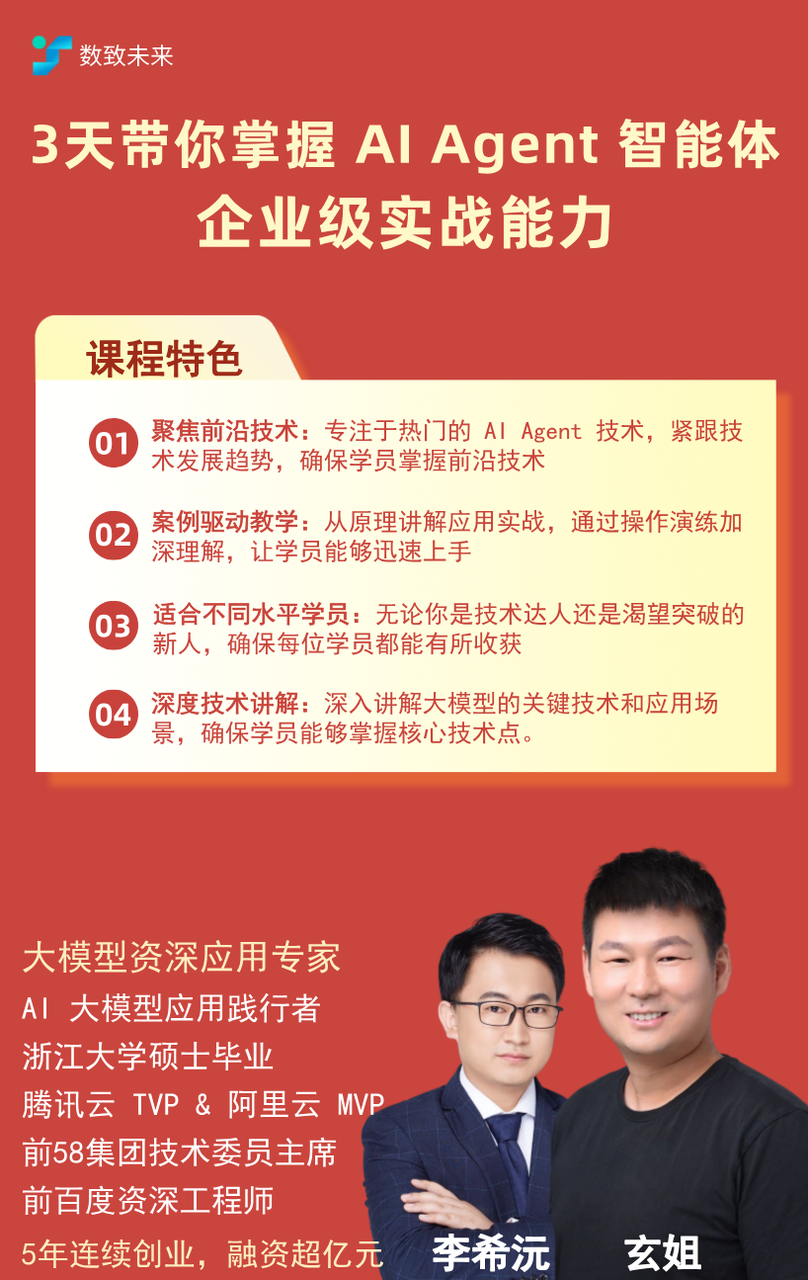
The course was originally priced at 199 yuan, the New Year is approaching, and now you can get it for only 19 yuan! Four registration benefits will be given at the end of the article! Once sold out, it will immediately return to 199 yuan!
—10—
What can you gain from the 3-Day Live Training Camp?
In three days of live classes, you will quickly master the core technologies and enterprise-level project practical experience of AI Agents.
Module 1: Principles of AI Agent Technology
Comprehensively dismantle the principles of AI Agent technology, deeply master the three core capabilities of AI Agents and their operating mechanisms.
Module 2: Practical Development of AI Agents
Deeply explain the technology selection and development practice of AI Agents, learning to develop the core technical capabilities of AI Agents.
Module 3: Enterprise-Level Case Practice of AI Agents
From demand analysis, architecture design, architecture technology selection, hardware material planning, core code implementation, to service governance, learn the key and difficult problem-solving of the entire process of enterprise-level AI Agent projects.
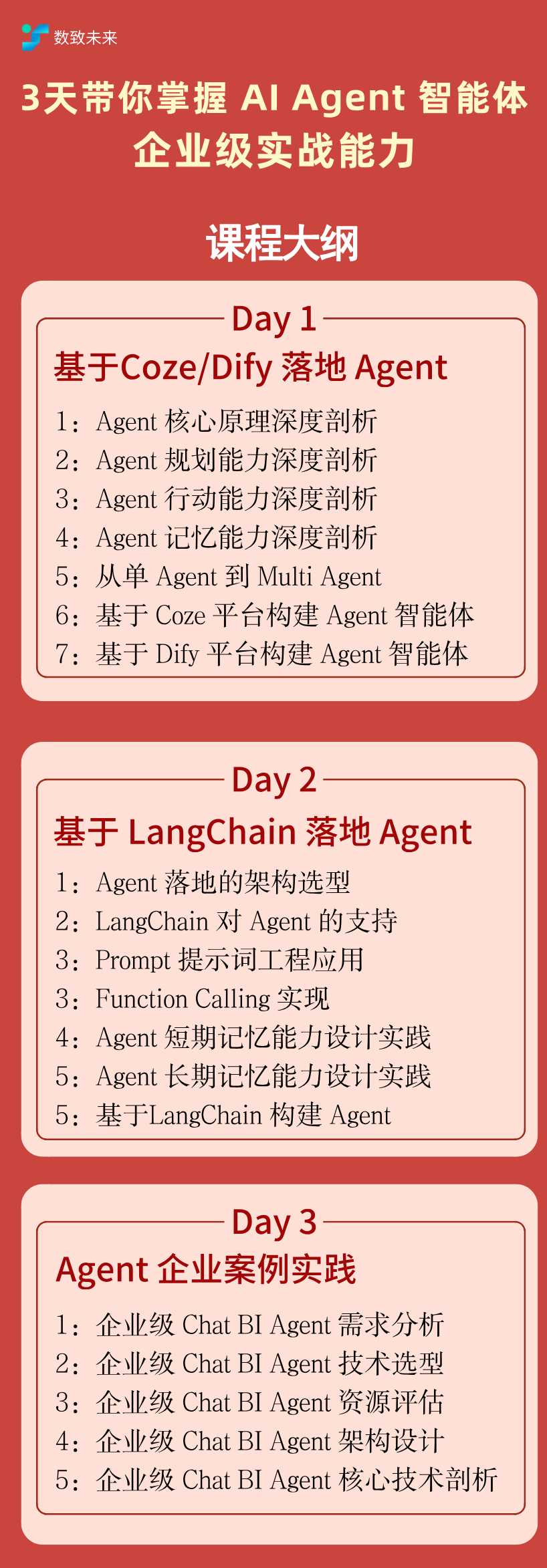
Limited Time Offer:
—11—
Register today and receive 4 accompanying benefits
Benefit 1: AI Agent training camp accompanying learning materials, including: PPT courseware, practical code, enterprise-level agent cases, and supplementary learning materials.
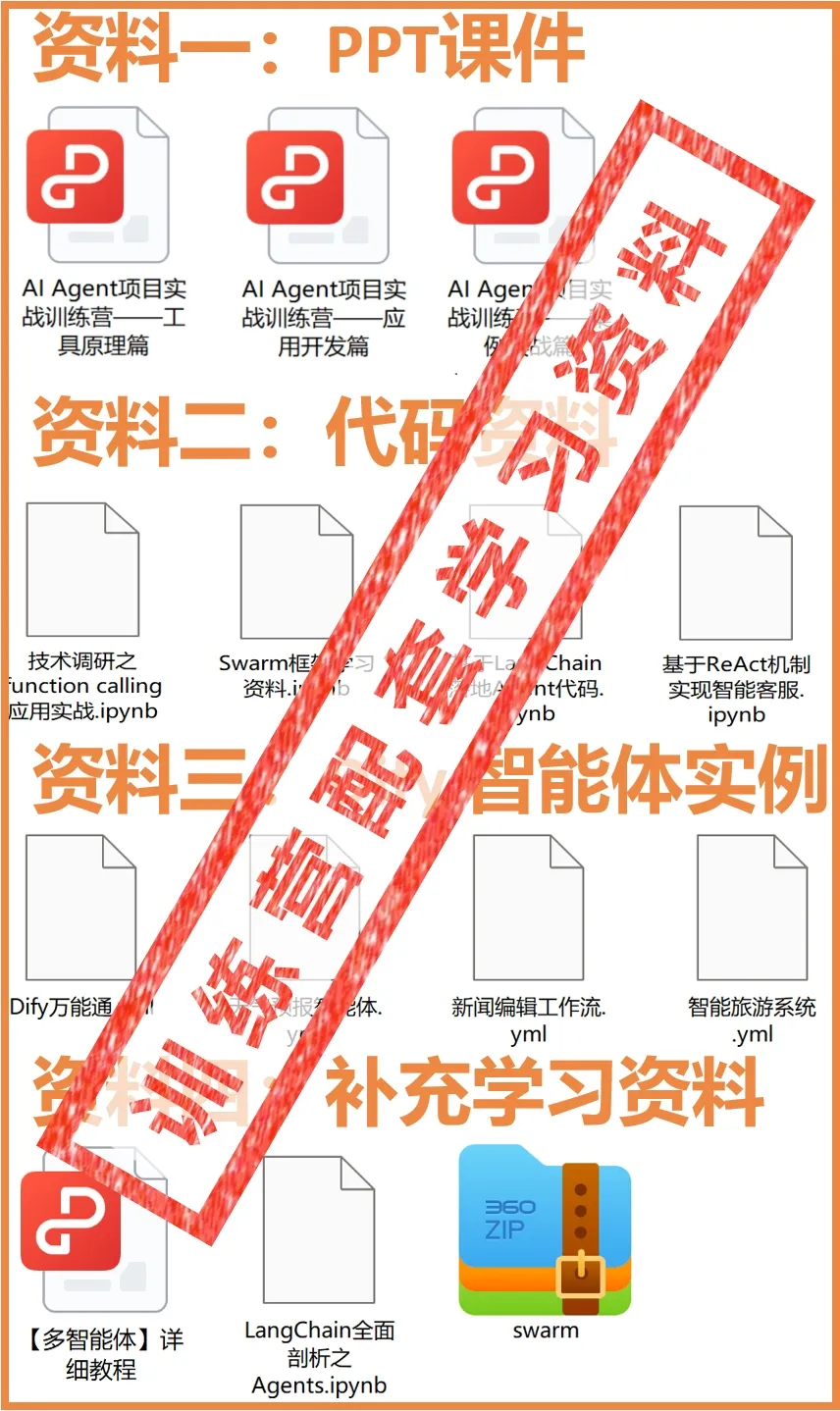
Benefit 2: AI Agent training camp study notes, covering all the highlights of the three-day live broadcast.
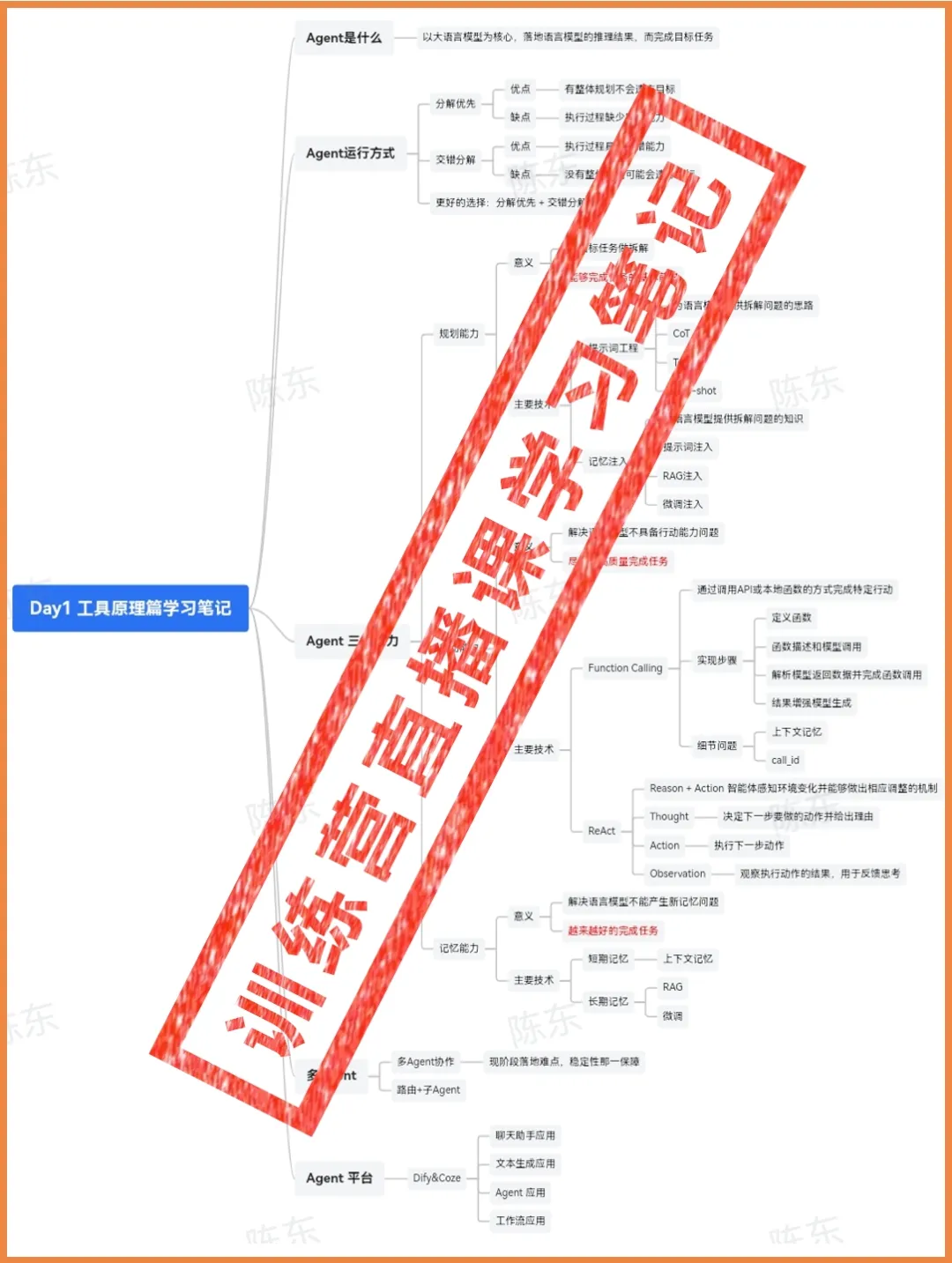
Benefit 3:100 real interview questions from top companies for AI Agents! Covering 100 real questions from major companies like Baidu, Alibaba, Tencent, ByteDance, Meituan, Didi, the reference significance is substantial for both job-hopping and promotion!
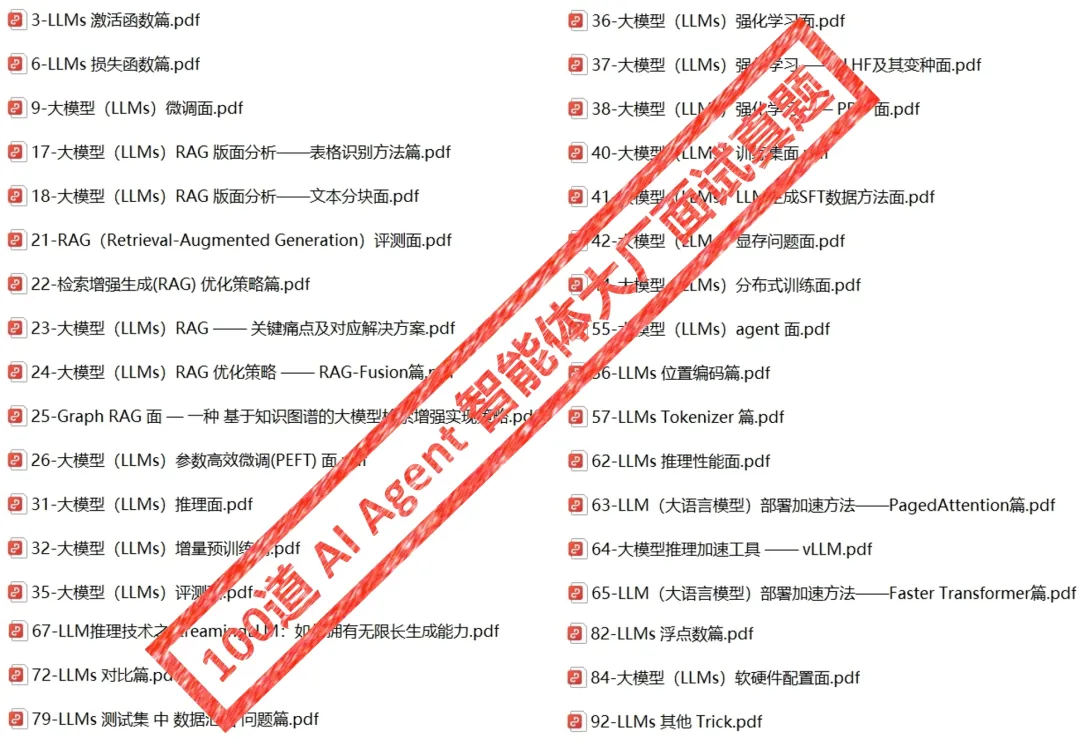
Benefit 4:2024 China AI Agent industry research report! AI Agents are a new application form, the “APP” of the large model era, and the technical paradigm has also changed significantly. This research report explores the new generation of human-computer interaction and collaboration paradigms, covering technology, products, business, and enterprise implementation applications, and is definitely worth reading!
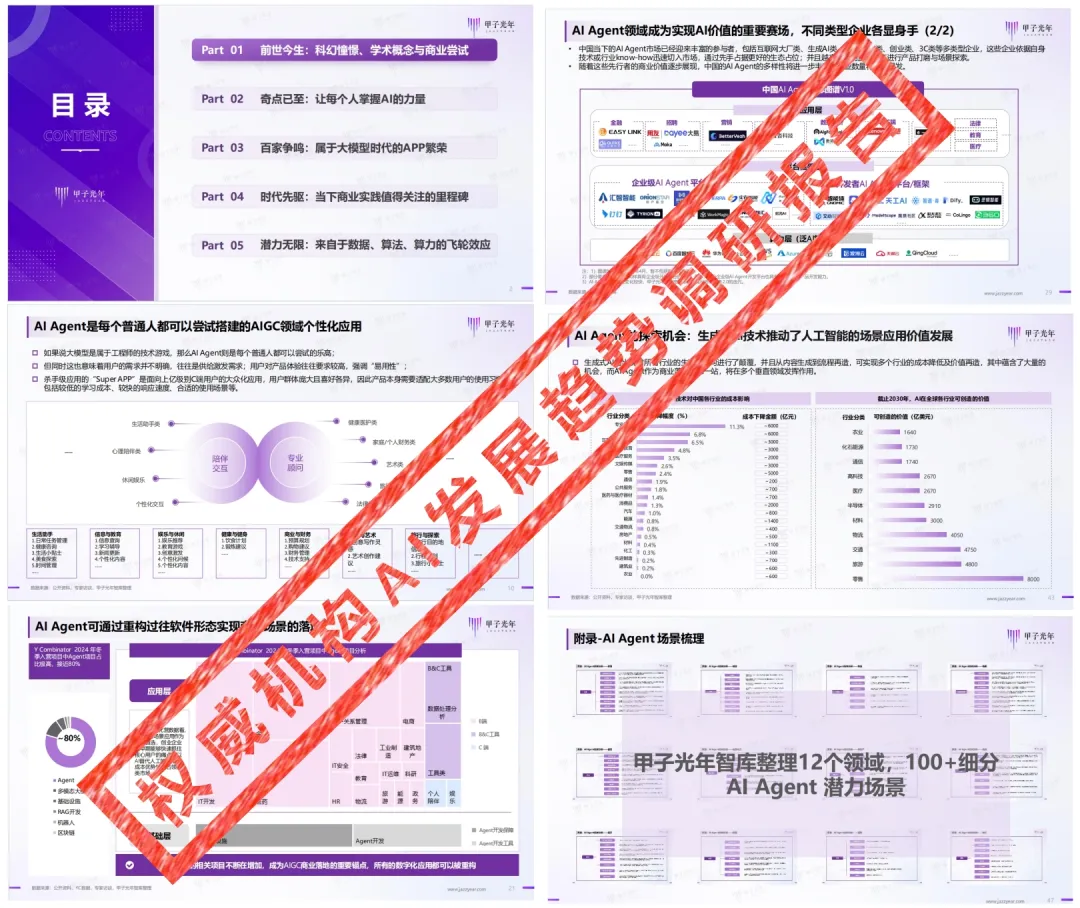
Originally priced at 199 yuan, The New Year is approaching, now you can get it for 19 yuan!
—12—
Add assistant for live learning
After purchase, add the assistant for live learning👇

Add the assistant’s QR code after registration to immediately receivefour benefits!
Reference:
https://mp.weixin.qq.com/s/olKWkWvZwHGmrfpcSG8lNQ
END
